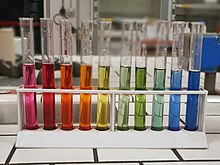unit of measure that describes the alkalinity or acidity of a solution. Negative log of the hydrogen ion concentration. Measured on a scale from 0 to 14. Greater than 7 is alkaline. less than 7 is acid. and 7 is neutral (pure water) (see acidity and alkalinity).
In chemistry, pH (/piːˈeɪtʃ/ pee-AYCH), also referred to as acidity or basicity, historically denotes "potential of hydrogen" (or "power of hydrogen"). It is a logarithmic scale used to specify the acidity or basicity of aqueous solutions. Acidic solutions (solutions with higher concentrations of hydrogen (H+) ions) are measured to have lower pH values than basic or alkaline solutions.

The pH scale is logarithmic and inversely indicates the activity of hydrogen ions in the solution
where [H+] is the equilibrium molar concentration of H+ (M = mol/L) in the solution. At 25 °C (77°F), solutions with a pH less than 7 are acidic, and solutions with a pH greater than 7 are basic. Solutions with a pH of 7 at 25 °C are neutral (i.e. have the same concentration of H+ ions as OH− ions, i.e. the same as pure water). The neutral value of the pH depends on the temperature and is lower than 7 if the temperature increases above 25 °C. The pH range is commonly given as zero to 14, but a pH value can be less than 0 for very concentrated strong acids or greater than 14 for very concentrated strong bases.
The pH scale is traceable to a set of standard solutions whose pH is established by international agreement. Primary pH standard values are determined using a concentration cell with transference by measuring the potential difference between a hydrogen electrode and a standard electrode such as the silver chloride electrode. The pH of aqueous solutions can be measured with a glass electrode and a pH meter or a color-changing indicator. Measurements of pH are important in chemistry, agronomy, medicine, water treatment, and many other applications.

![{\displaystyle {\ce {pH}}=-\log _{10}(a_{{\ce {H+}}})\thickapprox -\log _{10}([{\ce {H+}}]/{\ce {M}})}](https://wikimedia.org/api/rest_v1/media/math/render/svg/4bb26facbd1582452824ae7fa3636081a55503f0)